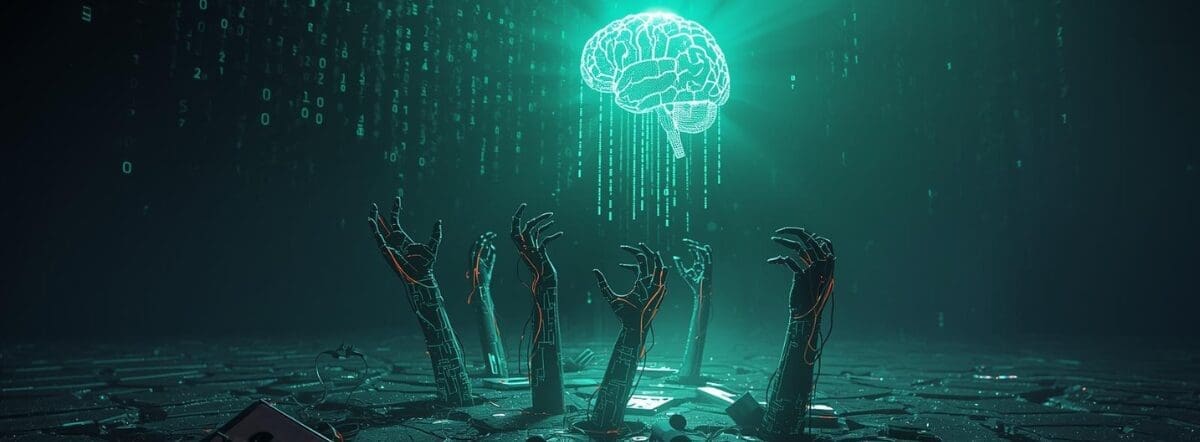Picture this: it’s a dark and stormy night in the tech department. The lights flicker. A developer tiptoes through thousands of lines of undocumented code. Somewhere in the distance, a server groans. It’s not a horror movie. It’s a legacy system!
While “legacy system” may not literally crawl out of a crypt, it haunts modern businesses just the same. These systems, often old, creaky, yet mission-critical, stick around for a reason. As Doug Compton, Principal AI Developer at Slingshot, put it: They’re “Old and outdated.”
But if these ghosts of technology past are so problematic, why haven’t we buried them?
David Galownia, CEO of Slingshot, offers one answer: “There’s oftentimes years, even decades, of business rules and hidden functionality, and nobody really remembers how it works.”
The cost to rewrite is enormous. The risk of breaking something mission-critical? Terrifying. So companies tolerate the hauntings, even as productivity drags and developer morale wanes.
What if we told you there’s a new kind of magic that doesn’t require a complete rewrite? One that doesn’t fear legacy code but understands it? That magic is AI.
Summary
Legacy systems may be outdated, but they’re often packed with irreplaceable business logic and hidden functionality. Replacing them can be risky and expensive. Ignoring them, however, drags down productivity and innovation. Enter AI: a powerful tool not for rewriting, but for resurrecting. With the ability to document forgotten code, surface hidden logic, and automate testing, AI transforms legacy software from a liability into a strategic asset.
But the magic only works with the right setup, strong safeguards, and human oversight. For companies willing to listen to their tech ghosts, AI offers a new path forward; one where the past powers the future.
Don’t Rewrite, Resurrect: Why AI Loves Legacy Code
Let’s be clear: AI can’t instantly transform ancient systems into sleek modern platforms. But it can do something almost as powerful: breathe new life into them.
Doug doesn’t hesitate: “The very first thing anybody should do with a legacy system now that they’ve got AI is have it document the system.”
Documentation is often the first victim of system aging: Developers leave, code changes hands, and comments disappear. AI tools can scan your old files, reverse-engineer flow charts, generate documentation, and uncover what a system actually does.
AI becomes your ghost-hunting flashlight, helping teams see what’s really inside those haunted lines of code.
The Fear of Change: Why No One Wants to Touch Legacy Systems
It’s not just the system that’s old; the fear around it is ancient too.
Doug nails the emotional undertone: “Typically, people are afraid to make changes to legacy systems because they don’t know what that change will affect.” In other words, no one wants to be the one who breaks everything.
David adds, “If you get stuck working on a legacy app, your skills could become outdated. Or you get typecast as the legacy guy.”

That kind of developer dread adds to the business risk. AI tools can help with this, too. For instance, they can:
- Generate unit tests for high-risk sections of code
- Surface the undocumented business logic
- Run code reviews with AI agents for security flaws
- Identify dependency vulnerabilities in old packages
These tools don’t just make the work easier; they make it safer. Like a protective talisman for developers.
AI Agents, Assemble: Your New Ghostbusters for Code
If AI is the magic, then AI agents are the spellcasters. These specialized bots can proactively sniff out trouble.
Doug lists a few favorite use cases: “We’ve been talking about code review agents, security auditor agents, and dependency auditor agents.”
AI agents can flag issues humans might miss, such as outdated packages, SQL injection risks, or insecure access points. Especially in legacy systems, where the original developers may be long gone, these agents act like a paranormal investigation team for your tech stack.
Thanks to AI, test automation (once a laborious and expensive undertaking) is now feasible, even for legacy code. David says it well: “With AI, automation is now a much smaller investment to implement.”
What used to be a costly exorcism is now more like a house cleaning.
The AI Onboarding Ritual: You Can’t Skip the Setup
Before you unleash AI on a legacy system, even just to analyze it, there’s one crucial step: onboarding. Doug gives this chilling reminder: “You have to onboard your AI almost like it’s a new employee.”
It’s essential to help AI understand what it’s looking at in the first place. Legacy systems often lack documentation, the business rules are buried, and the architecture is obscure. Just as a new employee, AI tools can only work well if they’ve been given the correct information up front.
You need to provide the context first: what the application does, how it’s structured, and what rules govern its behavior. As Doug said, “You can’t just tell AI to ‘fix this’ and expect it to know everything magically, unless you give it that information.”
Without onboarding, AI becomes just another developer fumbling in the dark. With it, you gain smarter insights, more precise documentation, and increased confidence in the system’s actual functionality.
This step isn’t a spell. It’s a process, and it’s the first step in making your legacy system a little less haunted.
Raising the Dead Responsibly: Don’t Invite Vampires In
The power of AI to document, test, and automate around legacy systems is real. But so are the risks, especially when it comes to data.
Doug points out a common concern: “You’ve got to make sure you don’t do the triad of security mistakes: providing AI with sensitive data, giving it access to the outside world, and letting it act without oversight.”
There’s a right way to bring AI into your legacy infrastructure. It starts with good hygiene:
- Set boundaries on what AI can access
- Use on-prem or secure AI models for sensitive data
- Don’t allow generative AI to write production code unchecked
- Always keep a human in the loop

In the wrong hands, legacy systems become horror stories. But with the proper safeguards, they become something else entirely: a bridge to the future.
What’s Next: The Resurrection of Resilience
There’s something beautiful about the idea of not scrapping everything old, but instead transforming it.
AI doesn’t mean we abandon the past. It means we learn from it faster, understand it better, and build from it more confidently. We make legacy systems resilient, not scary.
So this Halloween, don’t fear the legacy system. Listen to it. Understand it. And with the right AI tools at your side, raise it from the dead.
Happy Haunting!
Want More Halloween Fun?

Written by: Savannah Cherry
Savannah is our one-woman marketing department. She posts, writes, and creates all things Slingshot. While she may not be making software for you, she does have a minor in Computer Information Systems. We’d call her the opposite of a procrastinator: she can’t rest until all her work is done. She loves playing her switch and meal-prepping.

Expert: David Galownia
David excels at propelling Slingshot towards their goals and oversees the strategic direction of the company. He’s been described as ‘intense, driven, caring, and passionate’ both at work and play. At work, he enjoys watching his team explore, imagine, and reinvent to do the best by their clients. At play, he drives Karts at insanely high speeds and scares his wife half to death. It’s all or nothing. Which means he gives it all.

Expert: Doug Compton
Born and raised in Louisville, Doug’s interest in technology started at 11 when he began writing computer games. What began as a hobby turned into his career. With broad interests that range anywhere from snorkeling, science, WWII history and real estate, Doug uses his “down time“ to create new technologies for mobile and web applications.
Frequently Asked Questions
Legacy systems often contain deeply embedded business logic and decades of functionality. Replacing them is risky, expensive, and time-consuming. Many companies tolerate their limitations to avoid disrupting mission-critical operations.
AI can analyze, document, and automate parts of a legacy system without needing a full rewrite. It helps teams understand what the system does, generates flow charts, and identifies vulnerabilities—making modernization faster and safer.
Begin by onboarding AI like a new team member. Provide context, define business rules, and explain the system’s structure. This ensures the AI delivers meaningful documentation, insights, and automation support.
It can be safe if proper safeguards are in place. Use secure, on-prem AI tools for sensitive data, restrict access boundaries, and always keep a human in the loop to verify outputs. Avoid letting AI act autonomously in production environments.
Yes. AI agents can automate documentation, identify bugs, generate unit tests, and surface security flaws. This reduces manual effort, improves safety, and restores confidence in working with aging systems.




